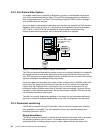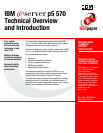Chapter 3. Capacity on Demand, RAS, and manageability 63
3.4 Cluster 1600
Today's IT infrastructure requires that systems meet increasing demands while offering the
flexibility and manageability to rapidly develop and deploy new services. IBM clustering
hardware and software provide the building blocks, with availability, scalability, security, and
single-point-of-management control, to satisfy these needs.
IBM Sserver Cluster 1600 is a POWER-based AIX 5L and Linux Cluster targeting scientific
and technical computing, large-scale databases, and workload consolidation.
IBM Cluster Systems Management (CSM) is designed to provide a robust, powerful, and
centralized way to manage a large number of POWER5-based systems from a single point of
control. CSM can help lower the overall cost of IT ownership by helping to simplify the tasks of
installing, operating, and maintaining clusters of servers. CSM can provide one consistent
interface for managing both AIX and Linux nodes (physical systems or logical partitions), with
capabilities for remote parallel network install, remote hardware control, and distributed
command execution.
The p5-570 is supported with the Cluster 1600 running CSM for AIX, V1.3.1. To attach a
p5-570 to a Cluster 1600, an HMC is required. One HMC can also control several p5-570s
that are part of the cluster. If a p5-570 that is configured in partition mode (with physical or
virtual resources) is part of the cluster, all partitions must be part of the cluster.
It is not possible to use selected partitions as part of the cluster and use others for non-cluster
use. The HMC uses a dedicated connection to the p5-570 to provide the functions that are
needed to control the server, such as powering the system on and off. The HMC must have
an Ethernet connection to the Control Work Station (CWS). Each partition in p5-570 must
have an Ethernet adapter to connect to the CWS
trusted LAN.
Information about HMC control, cluster building block servers, and available cluster software
can be found in the following link:
http://www.ibm.com/servers/eserver/clusters/
The benefits of clustered environment based on logical partitions
Evolving processor and storage technologies has had a great impact on the architecture of IT
infrastructures. This was the most significant challenge for the infrastructure in the past and
will continue to be in the future. During the first half of the 1990s, one central instance of an
application per node was suitable; moreover, most productive systems needed additionally
associated nodes, so called application servers.
Increasing performance and reliability by simply replicating application server nodes led to
complex environments that often resulted in poor system management. The reason for these
complex constructions was the limited computing power of a single node. This limitation was
softened during the second half of the 1990s.
Big symmetric multiprocessor (SMP) nodes with higher clock rates and increased memory
provided the ability to install more than one system on a node. This had some side effects
regarding systems operations: a release’s planning processes had to pay attention to different
databases, application versions, or both to avoid unresolved conflicts.
In 2000, Workload Manager for AIX (WLM) was announced. Multiple application instance
installations became more and more popular because of the permanently increasing number
of systems that were dedicated to applications at customer sites. The general availability of
this functionality of AIX to separate the workloads of dedicated systems eliminated the last
obstacle for consolidating several systems into one node.


















